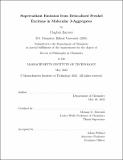Superradiant Emission from Delocalized Frenkel Excitons in Molecular J-Aggregates
Author(s)
Barotov, Ulugbek
DownloadThesis PDF (53.64Mb)
Advisor
Bawendi, Moungi G.
Terms of use
Metadata
Show full item recordAbstract
Coherent coupling of excitations between chromophores in molecular J-aggregates leads to delocalized Frenkel excitons that span multiple molecules in the aggregate. Delocalized Frenkel excitons in molecular J-aggregates provide an avenue to access high-speed fluorescent materials with unique optical properties such as strong absorption, long-range exciton transport, and, in particular, superradiant emission with short radiative lifetimes and narrow linewidths. Despite these favorable optical properties, fundamental studies as well as applications of J-aggregates as high-speed light sources have been hindered by their low photoluminescence quantum yields (QYs), negligible Stoke’s shifts, and poor structural and optical stability, all leading to diminished fluorescence efficiencies in many device applications. In this thesis I perform in-depth structural and optical studies to understand non-radiative processes in J- aggregates and develop high-speed materials with short lifetimes, high QYs, and large extinction coefficients.
In the first part I investigate whether non-radiative losses in J-aggregates originate from nonradiative processes specific to the isolated constituting molecules and demonstrate a bottom-up approach to design novel emissive J-aggregates. I first select a J-aggregating cyanine chromophore and reduce its nonradiative pathways by rigidifying its backbone. The resulting conformationally restrained cyanine dye self-assembles in water-methanol mixtures to form highly emissive J-aggregates with micron-scale two-dimensional sheetlike morphology. These novel J-aggregates have strong, red-shifted absorption at 600 nm and a resonant fluorescence with no Stokes shift, 50% QY, and 220 ps lifetime at room temperature. I stabilize the rigidified dye aggregates in a glassy sugar matrix and study their excitonic behavior using temperature-dependent absorption and fluorescence spectroscopy, which confirm J-type excitonic coupling and superradiance, both necessary for obtaining fast radiative rates. Even though non-radiative rates are significantly reduced in the rigidified dye J-aggregates, competing non-radiative processes originating from imperfections in the J-aggregate lattice still exist.
In the second part I perform in-depth investigations to elucidate the nature of nonradiative recombination sites specific to the J-aggregate lattice and demonstrate three general effective strategies to mitigate non-radiative losses in the superradiant emission from molecular J-aggregates. I focus on J-aggregates of 5,5′,6,6′-tet- rachloro-1,1′-diethyl-3,3′-bis(4sulfobutyl)-benzimidacarbocyanine (known as TDBC) and show that self-annealing at room temperature, photo-brightening, and the purification of the dye monomers all lead to substantial increases in emission QYs and a concomitant lengthening of the emission lifetime, with purification of the monomers having the largest effect. We use structural and optical measurements to support a microscopic model that emphasizes the deleterious effects of a small number of impurity and defect sites that serve as non-radiative recombination centers. This understanding has yielded a room temperature molecular fluorophore in solution with an unprecedented combination of fast emissive lifetime and high QY. We obtain super- radiant emission from J-aggregates of TDBC in solution at room temperature with a QY of 82% coupled with an emissive lifetime of 174 ps. This combination of high QY and fast lifetime at room temperature makes supramolecular assemblies of purified TDBC a model system for the study of fundamental superradiance phenomena.
In the last part I show that silica encapsulation and electrostatic coupling to quantum dots both lead to effective stabilization of structural and optical properties of J-aggregates. In addition, I propose a novel hybrid molecular aggregate system to introduce artificial Stoke’s shifts in molecular J-aggregates to overcome their reabsorption losses. Overall, I believe results presented in this thesis lay a foundation for the development of a new generation of organic fluorophores that combine high speed, high QY, and solution processing.
Date issued
2022-05Department
Massachusetts Institute of Technology. Department of ChemistryPublisher
Massachusetts Institute of Technology